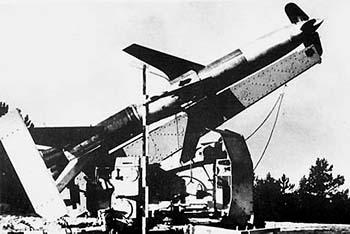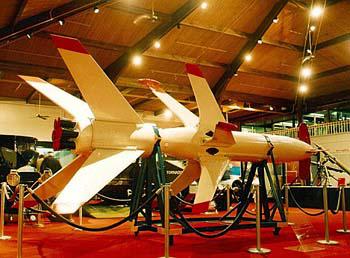
The 'Aerial Target' and 'Aerial Torpedo' in GermanyRheinmetall-Borsig
 Rheinmetall-Borsig Rheintochter 'Rhine Daughter' Surface-to-Air Missile http://www.felixent.force9.co.uk/games/art23.html
Rheinmetall-Borsig Rheintochter 'Rhine Daughter' Surface-to-Air Missile http://home.inreach.com/rickylaw/dictatorship/wonder/missile/rheintoc/rheintoc.html The famous and versatile Rheinmetall-Borsig company developed the Rheintochter ground-to-air missile from 1942 onwards. The first experimental launching tests began in August 1943, and 82 had been fired and tested by 5 January 1945. Only four out of those 82 had failed. The propulsion mechanism included a motor driven by solid fuel, and a solid booster unit for initial take-off. Like the Schmetterling missile, the Rheintochter was guided through radio command, and tracked visually by meand of flare attached to the wings and fins. The warhead composed of 300lb of high explosive and was armed by a "Kranich" acoustic proximity fuze, like the X-4. The design altitude of the original Rheintochter was 8000 meters, but the RLM rejected the design, requesting more altitude from the missile. The power system was then revised to employ solid or liquid fuels, and the booster rockets were placed outside the missile. It was also designed to be launched from an immovable launch site in a pit. This new version came to known as the Rheintochter 3, and production began in May 1944. Six had been built and fired by January 1945, but imperfection still plagued the control system. Development and thus production was canceled on 6 February 1945, as it became clear that the missile was not likely to be ready in time to have a significant impact on fate of the Reich.
 Rheinmetall-Borsig Rheintochter 'Rhine Daughter' Surface-to-Air Missile http://www.netaxs.com/people/ebailey/museumphotos.html
Rheinmetall-Borsig Rheintochter Surface-to-Air Missile http://icarus.simplenet.com/RealHardware/Rheintochter/RheintochterTop.htm The Rheintochter surface to air missile was first ordered by the German Army in November of 1942 as a way of reinforcing anti-aircraft batteries across Germany. Built as a two stage rocket with solid propellants, the top stage contained the warhead at the rear and guidance control fins at the front. Its flight was controlled remotely by an operator on the ground and it used flares placed in the "tip pods" to help visualize its flight path. Warhead detonation was also commanded by signals from the ground. Designated "R1", Rheintochters made 82 test firings between August 1943 and December 1944 before the project was canceled. An air launched version was also designed which would have used a smaller liquid rocket propulsion system but this too was canceled after only 6 test launches. Although promising, the Rheintochter would require time to develop that Germany just didn't have so materials and labor were transferred to other projects which were closer to production.
The Rheintochter missile started development in 1942 under the auspices of the Rheinmetall-Borsig company. Test firing of the missile began in the August of the following year, and by January 1945, over eight had been fired. Of these, only four failed. It carried over one hundred and fifty kilograms of high explosive and was detonated using a proximity fuse. It would be launched from a permanent emplacement site. The Luftwaffe turned down the original design, because the altitude was restricted to 8000 metres. The missile was redesigned and redesignated the Rheintochter III. Work began in May 1944, development was delayed because of work still needed on the control system, but was eventually stopped in February 1945, because it was thought to be unlikely to be completed in time to have any effect on the war.
|
© Copyright 1999 CTIE - All Rights Reserved - Caution |